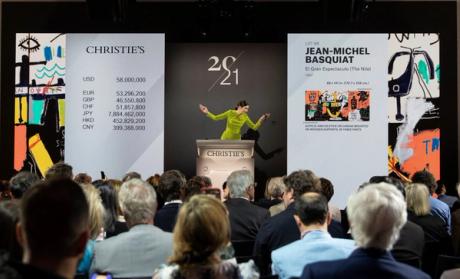
“This has been a paradoxical year,” said Christie’s chief executive, Guillaume Cerutti, at the auction house’s end-of-year press conference, held yesterday (18 December). Despite the art market’s continued contraction, he sought to spotlight Christie’s “judicious investments in innovation and expansion” alongside select positive results.
Whether 2023 can be judged as a success or failure is down to perspective, according to Cerutti. The auction house projects to make $6.2bn in global sales of art and luxury goods by year’s end—25% less than the $8.4bn it earned in 2022. Although the house expects private sales to have risen 5% year-on-year, this increase is not nearly enough to offset its auction sales of art and luxury goods falling around 30.5%, from $7.2bn last year to an estimated $5.0bn in 2023.
The exceptional circumstances of 2022 are an obvious caveat. Christie’s sale of works from the Paul G. Allen collection brought more than $1.6bn overall—most of it during a record-smashing $1.5bn evening auction—boosting the auction house’s annual sale total to a highest-ever $8.4bn worth of art and luxury goods. This proved a difficult act to follow, particularly after Christie’s failed to secure the highest-value estate offering of 2023.
“Do not underestimate how much a single collection can affect our results,” Cerutti said. “Had we landed the Emily Fisher Landau Collection, the results would have been different.”
Sotheby’s, which outcompeted Christie’s for Fisher Landau’s art holdings, will release its results for 2023 next month.
Shifting calendar
Christie’s promises to deliver a major moment with the opening of its new Asia Pacific headquarters in Hong Kong next year. Currently, its auction dates there “are dictated by the Hong Kong Convention and Exhibition Centre schedule”, Cerutti said. The auction house’s move will result in a more “evenly distributed sales calendar”, added Marcus Fox, its global managing director of 20th and 21st century art.
This shift could help to smooth Christie’s earnings across more locations and seasons, as opposed to its heavy reliance on the May and November auctions in New York in recent times. “It’s not practical to sell half the year in a few weeks,” Cerutti said. “The move to Hong Kong will address this in terms of volume, as well as price.”
And despite jitters around a cooling Chinese market, the data shows mainland China provided the largest share of new client spend worldwide in 2023. The number of first-time buyers from Gen Z also more than doubled in the Asia Pacific region year-on-year.
Other growth markets included Paris, which sold €126.6m ($136.5m) worth of art and luxury goods during Christie’s auction week coinciding with Paris+ par Art Basel in October; this sum was a 54% increase on the total from last year’s equivalent sales. Leading the way was Joan Miró’s Peinture (Femmes, lune, étoiles) (1963), which sold for €20.8m (with fees), the highest price paid for a painting at auction in France, according to Christie’s.
Private sales maintain momentum
The rise of private sales at Christie’s also continues apace, with the department projected to amass $1.2bn, or 19.4% of the auction house’s total sales of art and luxury goods by the end of the year. In fact, the top transaction of 2023 was one conducted away from the public eye; it yielded “more than $100m”, Cerutti said, although he declined to provide any further information.
Speaking to other trends that emerged this year and will likely endure into the next, Cécile Verdier, the president of Christie’s France, noted that consignors are (finally) becoming amenable to more conservative estimates. Whether this move will ignite more active bidding—and perhaps more robust results overall—in 2024 is a question observers will have to wait another 12 months to find out.










